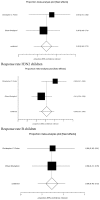Influenza and Pneumococcal Vaccination in Hematological Malignancies: a Systematic Review of Efficacy, Effectiveness, and Safety
- PMID: 27648207
- PMCID: PMC5016013
- DOI: 10.4084/MJHID.2016.044
Influenza and Pneumococcal Vaccination in Hematological Malignancies: a Systematic Review of Efficacy, Effectiveness, and Safety
Abstract
Background: The risk of getting influenza and pneumococcal disease is higher in cancer patients, and serum antibody levels tend to be lower in patients with hematological malignancy.
Objective: To assess flu and pneumococcal vaccinations efficacy, effectiveness, and safety in onco-hematological patients.
Methods: Two systematic reviews and possible meta-analysis were conducted to summarize the results of all primary study in the scientific literature about the flu and pneumococcal vaccine in onco-hematological patients. Literature searches were performed using Pub-Med and Scopus databases. StatsDirect 2.8.0 was used for the analysis.
Results: 22 and 26 studies were collected respectively for flu and pneumococcal vaccinations. Protection rate of booster dose was 30% (95% CI=6-62%) for H1N1. Pooled prevalence protection rate of H3N2 and B was available for meta-analysis only for first dose, 42.6% (95% CI=23.2 - 63.3 %) and 39.6 % (95% CI=26%-54.1%) for H3N2 and B, respectively. Response rate of booster dose resulted 35% (95% CI=19.7-51.2%) for H1N1, 23% (95% CI=16.6-31.5%) for H3N2, 29% (95% CI=21.3-37%) for B.
Conclusion: Despite the low rate of response, flu, and pneumococcal vaccines are worthwhile for patients with hematological malignancies. Patients undergoing chemotherapy in particular rituximab, splenectomy, transplant recipient had lower and impaired response. No serious adverse events were reported for both vaccines.
Figures





Comment in
-
H1N1 Influenza among Hematological Patients: Monocentric Influenza Cases from 2011 to 2016.Mediterr J Hematol Infect Dis. 2017 Mar 1;9(1):e2017024. doi: 10.4084/MJHID.2017.024. eCollection 2017. Mediterr J Hematol Infect Dis. 2017. PMID: 28293412 Free PMC article. No abstract available.
References
-
- Centers for Disease Control and Prevention and Control of Influenza. Recommendations of the Advisory Committee on Immunization Practices ACIP. MMWR. 2009;58:1–52. www.cdc.gov/mmwr/preview. - PubMed
-
- Mackay HJ, McGee J, Villa D, Gubbay JB, Tinker LM, Shi L, Kuruvilla J, Wang L, MacAlpine K, Oza AM. Evaluation of pandemic H1N1 (2009) influenza vaccine in adults with solid tumor and hematological malignancies on active systemic treatment. J Clin Virol. 50:212–216. 201. - PubMed
-
- WHO. Relevé épidémiologique hebdomadaire. Pneumococcal vaccines WHO position paper – 2012. Wkly Epidemiol Rec. 2012;87:129–144. - PubMed
-
- Hamborsky J, Kroger, editors. E-Book: The Pink Book. Public Health Foundation; 2015. A Epidemiology and prevention of vaccine-preventable diseases.
Publication types
LinkOut - more resources
Full Text Sources
Other Literature Sources

